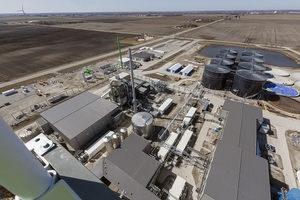USDA issues progress report on climate smart ag, forestry
Energy Disrupter
ADVERTISEMENT
The USDA on May 20 published its 90-Day Progress Report on Climate-Smart Agriculture and Forestry. The report reflects initial conversions with stakeholders on how the agency should develop its climate smart strategy and indicates bioenergy will play a significant role in meeting federal climate goals.
“Over the past months, USDA has heard the views of Tribes and stakeholders across agriculture and forestry on how USDA should develop its climate smart agriculture and forestry strategy,” wrote Agriculture Secretary Tom Vilsack in the report. “This report reflects some of those initial conversations, and in the coming months we look forward to continuing to work with you to develop and implement our approach. It will be multi-pronged and centered on voluntary incentives that benefit producers and landowners. We will look across climate science and research, forest health, outreach and education, existing programs, and new and emerging markets to advance climate-smart agriculture and forestry. All of this must be done in partnership with landowners, producers, state and local governments, Tribes, and other stakeholders across agriculture and forestry.”
The report is related to President Biden’s Jan. 27 executive order on tackling the climate crisis. Section 214 of that executive order focuses on empowering workers by advancing conservation, agriculture and deforestation. According to the executive order, “America’s farmers, ranchers, and forest landowners have an important role to play in combating the climate crisis and reducing greenhouse gas emissions, by sequestering carbon in soils, grasses, trees, and other vegetation and sourcing sustainable bioproducts and fuels.”
The order, in part, directed the USDA to collect within 60 days input from Tribes, farmers, ranchers, forest owners, conservation groups, firefighters, and other stakeholders on how to best use USDA programs, funding and financing capacities, and other authorities, and how to encourage the voluntary adaptation of climate-smart agricultural and forestry practices that decrease wildfire risk fueled by climate change and result in additional, measurable, and verifiable carbon reductions and sequestration that source sustainable bioproducts and fuels.
The USDA on March 15 announced the opening of a 45-day comment period to collect the input required by the executive order. Several topics addressed within the agency’s request for comments focused specifically on biofuels, bioproducts and renewable energy.
The USDA said it received more than 2,700 written comments during the comment period. The agency also hosted a series of 10 stakeholder listening sessions that were attended by more than 260 participants.
The report released May 20 takes note of the broad array of perspectives raised during these initial outreach activities, according to the USDA. Several common themes also emerged, with many respondents urging the agency to account for co-benefits of its CSAF strategy but cautioning against taking a one-size-fits-all approach.
The report lists seven recommended elements of a CSAF strategy, including prepare USDA to quantify, track, and report the benefits of CSAF activities; develop a CSAF strategy that works for all farmers, ranchers, forest land-owners, and communities; leverage existing USDA programs to support CSAF strategies; strengthen education, training, and technical assistance for CSAF practices; support new and better markets for agriculture and forestry products generated through CSAF practices; develop a forest and wildfire resilience strategy; and improve research.
Biofuels and bioenergy are mentioned several times under those seven elements. The report notes that a wide range of market-based approaches exist for incentivizing climate-friendly agriculture commodities, including voluntary offset and credit markets. “They can also include markets for low-carbon biofuels, renewable energy, and biobased and wood products,” the USDA said in the report. “These markets can promote voluntary adoption of conservation technologies and practices and leverage private-sector demand for GHG benefits associated with CSAF practices. These types of market opportunities can offer cost-effective ways to incentivize CSAF practice adoption and provide new income streams. Through the CSAF strategy, USDA should support the identification and verification of the GHG benefits associated with CSAF practices and facilitate the participation of farmers, ranchers, and landowners in new markets for CSAF goods and services.”
The report also stresses that USDA can support the role of agriculture in decarbonizing the transportation sector. “The growth of the U.S. biofuels sector, driven in part by the Renewable Fuels Standard, has reduced GHGs and strengthened the rural economy,” the agency wrote. “Ethanol produced from corn reduces GHG emissions relative to gasoline. Market opportunities such as California’s Low Carbon Fuels Standard and the 45Q Federal Tax Credit for carbon capture and sequestration can further drive down the GHG footprint of the biofuels sector. USDA should identify opportunities for agriculture and forestry to play a role in the production of low-carbon biofuel feedstocks, and for innovative technologies such as bioenergy with carbon capture (BECCS) to reduce emissions associated with biofuel production while spurring rural economic development.”
In addition, the report shows USDA should help position Tribes, farmers, ranchers, rural landowners, and environmental justice communities to be leaders in renewable energy development. This includes investments in renewable energy technologies, including those to produce liquid fuels, renewable natural gas (RNG) from livestock, and sustainable biomass for renewable energy generation. “Investments in these technologies can provide new market opportunities for Tribes and rural America and create new uses for agriculture and forestry waste products, while reducing GHG emissions,” the agency said.
Another section of the report stresses the opportunities associated with USDA support for the deployment and development of methane digesters, biogas, and biobased products. “The adoption of on-farm biogas capture technologies and the production of biobased products can provide producers with new income streams while also reducing GHG emissions and improving water quality,” according to USDA. “Opportunities to generate income from these technologies include the generation of renewable electricity and the production of biobased products from manure, renewable natural gas (RNG) and liquefied natural gas (LNG). USDA should support producers as they enter these new markets and consider innovative finance mechanisms to provide upfront capital for biogas technologies and encourage the connection of multiple small operations to provide economical renewable energy production.”
A full copy of the report can be downloaded from the USDA website.
















